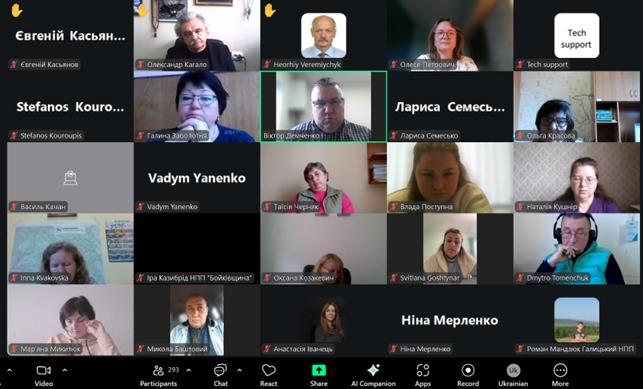On 7 November 2025, an online seminar titled “The Emerald Network in Ukraine: Developing Management Plans and Assessing Military and Anthropogenic Impacts” brought together representatives of government institutions, academia, civil society organizations, international partners, and experts from the Eastern Partnership countries.

The seminar focused on the development of management plans for Emerald Network sites, the assessment of military and anthropogenic impacts on these areas, and practical aspects of monitoring species and habitat conditions. The goal of the event was to raise awareness among specialists regarding the requirements of the Bern Convention, present methodological recommendations, and discuss ways to preserve biodiversity during wartime and the recovery period. The event was organized as part of Subcomponent 4.1 of the EU4Environment Programme: Support to Protect Biodiversity and Natural Ecosystems (Emerald Network), coordinated by the World Bank.
Opening remarks were delivered by Roman Romanik, deputy director of the department of protected areas and biodiversity – head of the division for organization of activities and coordination of nature reserve institutions and Stefanos Kouroupis, project coordinator, Particip GmbH.
In the first part of the seminar, Olesya Petrovych, team Leader of the project experts group (Particip GmbH), presented the requirements and recommendations of the Bern Convention on the management of Emerald Network sites, conservation objectives, monitoring measures, and reporting on changes in ecological character. Viktor Demchenko, project management expert and deputy director for research at the Institute of Marine Biology, NAS of Ukraine, then presented methodological recommendations for preparing management plans for Emerald Network sites, followed by a discussion among participants.
The second part of the seminar opened with a presentation by experts from the Conflict and Environment Observatory (CEOBS) — Doug Weir, Eoghan Darbyshire, Anna McKean, Iryna Babanina, and Linas Svolkinas — who shared methodological recommendations for assessing military impacts on Emerald Network sites.
Anna Kuzemko, senior researcher at the M.G. Kholodny Institute of Botany and representative of the NGO Ukrainian Nature Conservation Group, spoke about the specifics of habitat mapping. Natalia Brusentsova, head of the research department of the Kuyalnytsky National Nature Park, presented the possibilities of using geoinformation systems and remote sensing technologies in planning and assessing the condition of territories.
In the afternoon session, Aurel Lozan, EU4Environment activity coordinator in Moldova (World Bank), presented methodological approaches and the experience of developing and implementing management plans for Emerald Network territories in Moldova. The next session focused on censuses of flora and fauna across various taxonomic groups and assessment of population status. Viktor Shapoval, project expert and director of the Askania-Nova Biosphere Reserve, NAAS, presented on plants; Mykhailo Rusin, senior research fellow at the I.I. Schmalhausen Institute of Zoology, NAS of Ukraine, spoke about mammals; Oleksandr Bronskov, head of the research department of Meotida National Nature Park, presented on birds; and Viktor Demchenko, project management expert, discussed fish. In his presentation, Viktor Shapoval also addressed defining conservation objectives, organizing monitoring of species and habitats, and evaluating the impact of different factors.
During the final session, Oleg Diakov, project technical advisor and executive director of Rewilding Ukraine, discussed working with stakeholders, adaptive management mechanisms, adjusting conservation measures, and the stages of approving and revising management plans for Emerald Network territories. He emphasized that “an Emerald site is shared heritage, shared opportunities, and shared responsibility. Without coordinated action, there is degradation, conflict, and loss of values. Community participation means influence on decisions, access to resources, and building trust.”
One practical example discussed was the Tarutyno Steppe, which will form the basis for the future Budzhatski Steppes National Nature Park. Restoration activities in the region include the recovery of steppe areas, reintroduction of steppe species such as kulans and marmots, and active involvement of local communities in wildlife observation, fire prevention, and co-management of the territory.
The seminar demonstrated a high level of interest among Ukrainian and international experts in biodiversity conservation, experience exchange, and the implementation of European standards in protected area management. The organizers thanked all participants for their active engagement, informative presentations, and contribution to forming a shared vision for the development of the Emerald Network in Ukraine.
